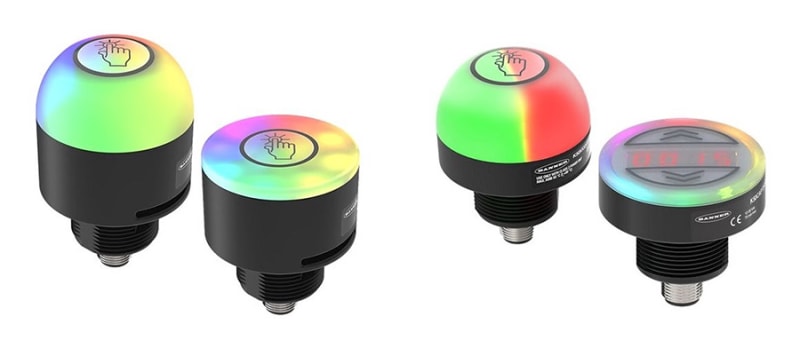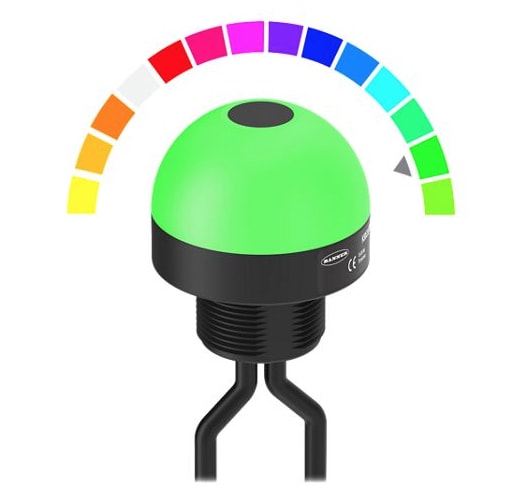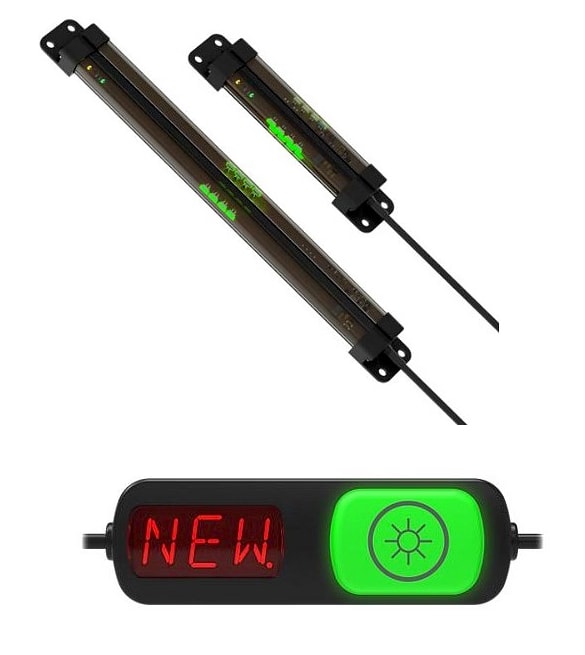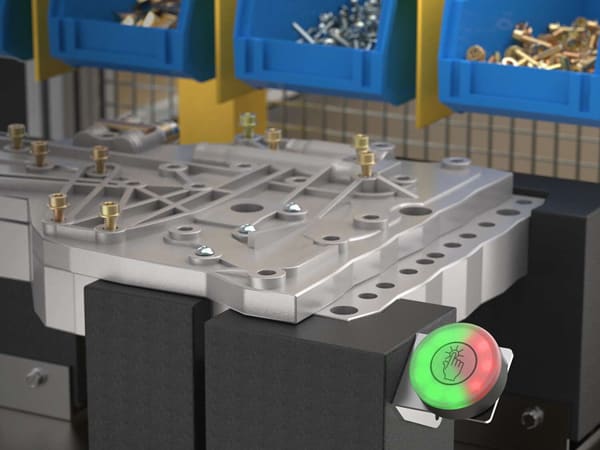Robb Weidemann, the Vice President of Product Management for Lighting and Indication Products at Banner Engineering, introduces pick-to-light solutions and explains how they can improve the efficiency and accuracy of picking, assembly, kitting, order fulfillment, and stocking processes in the manufacturing, material handling, and logistics industries.
Robb Weidemann, Vice President of Product Management for Lighting and Indication Products, Banner Engineering

Pick-to-light solutions make manual picking, assembly, kitting, order fulfillment, and stocking processes faster and more accurate and are widely used throughout the manufacturing, material handling, and logistics industries to improve efficiencies and throughput and maximize profits.
Pick-to-Light Solutions
Pick-to-light solutions, which are also known as light-directed or light-guided picking solutions, use colored LED indicators to guide users to the correct part or product location and can even indicate the number of parts to pick and proper pick order. As such, they significantly improve the quality and efficiency of manual picking, assembly, kitting, order fulfillment, and stocking processes, which are common throughout the industrial manufacturing industry and prone to human error — especially in applications with a lot of similar components or a demand for a wide variety of different parts.
Pick-to-light solutions help manufacturers prevent process defects caused by human error by either warning users that they’re about to make a mistake or preventing them from making a mistake. This makes it virtually impossible for users to complete an action incorrectly and can significantly improve productivity by keeping small mistakes from becoming bigger problems down the line. As such, pick-to-light solutions are one of the most popular error-proofing technologies for picking, assembly, and stocking processes. They’re also especially beneficial for training new employees to accurately complete these various tasks, training existing employees to complete new processes, and creating and maintaining lean manufacturing environments.
Basic Components of Pick-to-Light Solutions
Indicators are the most essential pick-to-light components and are available in pushbutton, capacitive touch, and non-contact formats, but sensors, industrial wireless communications devices, and tower lights can also play a key role in these systems.
Pick-to-Light Pushbutton Indicators require physical force to confirm picks. Although zero-force pick-to-light indicators are widely available, some users prefer the combination of tactile and visual confirmation. However, repeated button pushing can take a toll on workers’ hands and wrists.
Similar to the capacitive touchscreens we’re all familiar with, Capacitive Pick-to-Light Touch-Button Indicators only require surface contact to confirm picks. They can be operated with the simple and light touch of a finger, hand, or palm and with either bare or gloved hands. And since there’s no force required, they prevent stress on workers’ hands and wrists.



Non-Contact Pick-to-Light Indicators and Arrays are zero-force touch buttons that use a photoelectric sensor to detect workers’ hands and automatically verify picks and picking sequences as they execute their usual processes. They don’t require any physical contact or pressure to operate. As such, they offer an even more ergonomic and hygienic solution than capacitive pick-to-light indicators. In addition, non-contact arrays enable larger sensing areas, which can be crucial in some applications.
A great example of an array solution is Banner’s PVS28 Parts Verification Sensor Series, which provides optical sensing and intuitive touchless activation in a single, self-contained device that’s ideal for fast and reliable picking and fulfillment applications. The PVS28 series is available in two lengths compatible with both small and large bins and in three standard indicator colors; although, seven colors are available when using our Pro Editor software.
Some suppliers also offer ready-made Pick-to-Light Solutions Kits designed for quick and easy system setup and integration. Banner’s comes with a pre-programmed DXM controller and touchscreen HMI, is powered by PICK-IQ, a purpose-built serial bus protocol that delivers high-speed performance in even high-device-count networks, and is compatible with other PICK-IQ-compatible indicators and devices, including our K50 Pro and K50 Pro Optical Series indicators and PTL110 Series pick-to-light devices. Kits like these make it even easier and more economical for customers in the manufacturing, material handling, and logistics industries to leverage pick-to-light solutions and improve their productivity.
Common Pick-to-Light Applications
Pick-to-light solutions can be used in a wide variety of applications but are especially beneficial for picking, assembly, kitting, order fulfillment, and stocking processes, which are common in the manufacturing, material handling, and logistics industries. (pick to light)

Picking: Picking errors are common in multiproduct assembly stations where parts are manually assembled and there’s a demand for many different parts. Assembling multiple parts at a single station can be a very effective way to build components for various products, but it also presents several accuracy and throughput challenges. Similar-looking components, multiple sets of instructions, and complex, hard-to-follow instructions can all lead to human error, which can slow down entire processes and introduce defects. Using pick-to-light solutions in these applications reduces inaccuracies, speeds up build time, and makes it quick and easy to train employees.
Pick-to-light devices with an LED indicator, optical sensor, and alphanumeric display, like our PTL110 Series pick-to-light devices, make it easy to complete complex, multiproduct assemblies quickly and accurately. When a part is needed, the LED indicator on the part bin lights up, the display shows the required quantity, and the optical sensor recognizes when the operator has picked the parts. When a pick is completed, its LED indicator shuts off and the rest of the part bin indicators light up in sequence until the entire picking process is completed. Assemblers using our PTL110 Series pick-to-light devices can further benefit from high-speed PICK-IQ serial communication, which ensures that the system keeps up with the operator. They can also leverage different indicator colors to conveniently work on different products at a multiproduct assembly station, allowing them to quickly and accurately switch between BOMs and increase overall throughput.
Assembly: In addition to guiding picks, pick-to-light indicators with sequence mode capabilities, like our IO-Link compatible K50 Pro Series touch buttons, can be used to indicate takt time (the production rate required to meet demand) for assembly processes, which can improve efficiency throughout the production line and help maximize profits. Assemblers aren’t always aware of their own production pace or whether they’re working quickly enough to stay on track. But if their pace is too slow, it can slow down the entire assembly line and cause production goals to be missed. The visual feedback provided by pick-to-light indicators with sequence mode capabilities lets assemblers know how much time has elapsed without having to look away from their work and can help keep them on track. In sequence mode, each LED can represent a specified number of seconds. Green LEDs represent the amount of time remaining to complete the task, and red LEDs represent the amount of time spent on the task. So, when the majority of the LEDs are red, users know that time is running out.

Kitting: Kitting involves assembling and packaging separate but related items together and is used to provide a value-added service to end customers. It is also used to support the sequencing requirements of just-in-time manufacturing processes, which rely on the timely delivery of materials to ensure maximum production efficiency. For example, in automotive manufacturing, kits of parts are delivered to the next stage of production precisely when they’re needed. Assembling kits in this way is also known as offline or supermarket kitting.
The number of items often included in kits and the variety of kits that are typically assembled at a single station can make it easy for assemblers to lose track of the items they’ve already kitted, which can cause them to leave items out or add duplicate items. Errors like these increase overhead costs, make it challenging to manage part inventories, and can delay production processes and reduce customer satisfaction. Manual kit verification processes are a common mitigation practice, but these processes are time-consuming and prone to the same types of human error. Pick-to-light solutions can streamline kitting tasks by enabling verifiable accuracy at a fast pace. (pick to light)
Pick-to-light indicators with various color capabilities, like Banner’s 14-color K50 Pro and K50 Pro Optical Series, can be used to differentiate between the parts required for each of several different kits, enabling accurate simultaneous picking processes in even large and complex kitting operations. Devices with an alphanumeric display, like Banner’s PTL110 Series, can indicate part quantity. Push-button and touch-button indicators can be deactivated as each part is kitted to ensure accuracy, and non-contact indicators with optical sensing capabilities, like Banner’s K50 Core Optical, K50 Pro Optical, and PTL110 Series, can automatically detect when a hand reaches into the bin and breaks the sensing beam or array, and can even reliably detect dark gloves. Multi-color indicators can also change from green to yellow to confirm picks and illuminate red to indicate picking errors. These various solutions save time, improve efficiency, virtually eliminate errors, reduce overhead costs, increase profitability, and make it quick and easy to onboard new employees and train existing employees on new kitting processes.
Order Fulfillment: Order fulfillment refers to the process of receiving, processing, and delivering orders to end customers, and a critical step in this process is ensuring that the correct orders are picked from shelves. Quick and accurate order fulfillment increases customer satisfaction, and pick-to-light solutions can help — especially in applications with large volumes of orders, a high mix of inventory and pick points, and a small margin for error. These types of applications are ideal for fast-response pick-to-light solutions like the PTL110 Series with PICK-IQ, which uses a common ID to reduce the typical latency that results from polling multiple devices. They can also benefit from pick-to-light devices with optical sensing capabilities, which can verify accurate picks in real-time by changing from green to yellow indication or, if an operator reaches into an incorrect shelf, by turning red to indicate an error.
Stocking: Picking, assembly, kitting, and order fulfillment processes are only effective if the correct parts or products are in the right place and ready to be picked. So, efficient stocking, replenishment, and shelving solutions are vital to overall production efficiency and throughput. Pick-to-light solutions, which — in this context — would function as put-to-light solutions since picking is often done from one side of the rack and putting is done from the other, can help with this as well.

The picking, assembly, and kitting stations in manufacturing facilities must be replenished with parts before they run out in order to maintain process efficiency and achieve productivity goals. Push- and touch-button pick-to-light indicators paired with tower lights, like Banner’s TL50 Andon tower light assembly, which comes preassembled with a control box and enables easy-to-see status, can indicate that parts need replenishment or that picked parts, assemblies, or kits are ready to be transferred to the next station without requiring the workers to leave. Warehouses and distribution facilities require an efficient method of shelving inventory to ensure that orders are easily accessible during fulfillment. The same pick-to-light solutions used to ensure accurate order fulfillment can also be used to improve the efficiency and accuracy of stocking activities and help prevent downtime by reducing delays due to misplaced or incorrect orders.
Banner Engineering and RS: Your Trusted Pick-to-Light Solutions Suppliers
Banner Engineering is a leading global provider of industrial automation solutions engineered to improve efficiencies, reduce operating costs, safeguard equipment, and protect personnel. We offer more than 10,000 products backed by more than 55 years of innovation and industrial use, and many of those products, including a wide variety of our lighting and indication solutions like our pick-to-light products, are available at RS.
For more information about the Banner Engineering products available at RS, including indicators, sensors, tower lights, and industrial wireless communications devices, please click the links embedded here and throughout this article. For more information about Banner’s pick-to-light products and applications, please visit these links. For assistance identifying, procuring, deploying, and maintaining pick-to-light solutions that can help you improve the accuracy and efficiency of your picking, assembly, kitting, order fulfillment, and stocking applications, please contact your local RS representative at 1.866.433.5722 or reach out to the RS technical product support team.







